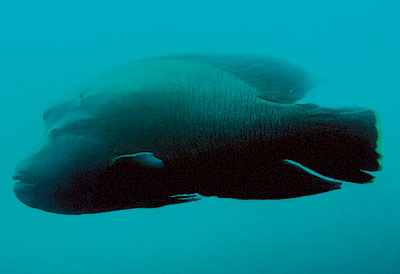News
Spear-fishing threatens Giant Coral Fish
View(s):By Malaka Rodrigo
Kalpitiya’s unsustainable fishing practices came under the spotlight recently after dozens of dolphins were killed after being trapped in banned fishing nets.
Besides the charismatic dolphin, other “endangered” marine creatures are falling victim to illegal fishing methods, including spear fishing. Spear fishing could wipe out the world’s biggest reef fish, the Hump-head Wrasse, from Kalpitiya and other marine areas, warn marine biologists.

A Hump-head Wrasse
The Hump-head Wrasse is also known as Napoleon Wrasse, and is scientifically categorised as Cheilinus undulates. The male can grow up to six feet (two metres) and can weigh up to 190 kilograms. It has a prominent bulge on its forehead, hence the name “hump head.” Some females have a sex change and turn into males with maturity. The Hump-head Wrasse can live up to 30 years, but many get killed even before reaching maturity.
Kalpitiya fisherman Chanaka says divers who dive for chank and sea cucumber also target the Hump-head Wrasse. “Most of the larger Hump-head Wrasse are gone from Kalpitiya,” Chanaka said. In a bid to survive, the giant fish sometimes hide in cavities in underwater caves, but this does not stop divers from shooting their spears into the cavities and killing the fish.
In times past, spear fishing was done with free diving, without scuba kits. The time a hunter can stay under water was limited, but now modern spear-fishing makes use of elastic powered spear-guns and slings, or compressed gas-powered spearguns to strike the fish with accuracy. The scuba gear allow the diver to stay underwater for long periods, and divers use the extra time to go for the larger fish.
Kalpitiya Bar Reef Sanctuary architect Arjan Rajasuriya confirmed that the Hump-head Wrasse is becoming a rarity in Kalpitiya. All the larger fish have been hunted, and the Hump Head Wrasse appears to be highly vulnerable to over-fishing, he said.
The absence of the Hump-head Wrasse could be bad for the health of the coral reef, says Mr. Rajasuriya. The Hump-head Wrasse feeds on hard-shelled prey such as mollusks, starfish, or crustaceans. This includes the coral-eating Crown-of-Thorn starfish. With the disappearance of the large fish, the Crown-of-thorn starfish population is increasing and putting the system out of balance. There was a Crown-of-thorn starfish outbreak at the Pigeon Island coral reef last year.
In 1996, the International Union for Conservation of Nature (IUCN) listed the Hump-head Wrasse as vulnerable. In the Red List of Threatened Species it was later upgraded to “endangered”. The fish is also targeted for the live restaurant fish trade, where fish are kept live in tanks for the customer to pick the fish he wants cooked for him. Samantha Gunasekara of Customs Biodiversity says this kind of trade is not found in Sri Lanka.
Marine biologist Nishan Perera said spearfishing is practised in other parts of the island as well. Not only the Hump-head Wrasse, but also Giant Groupers, Parrot Fish and most of the giant fish are being over-fished in our waters by spear fishing, he said. The Giant Grouper can grow up to three metres, but such big specimens are rare these days, Mr. Perera said.
Follow @timesonlinelk
comments powered by Disqus


















